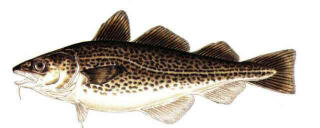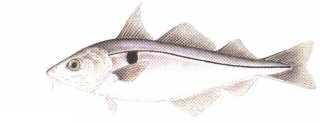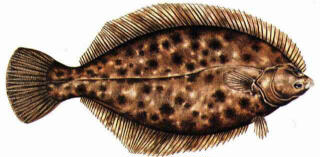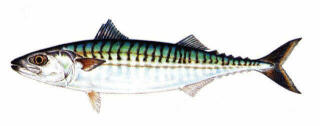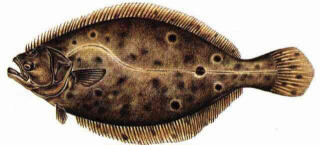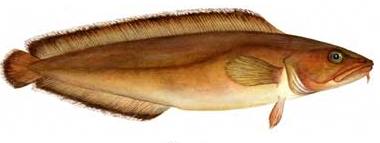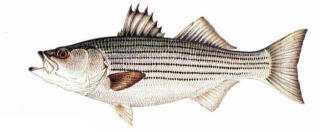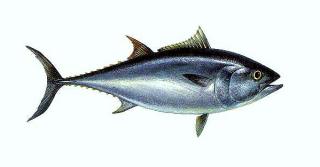|
Atlantic Cod For those brave souls who venture into the cold winter ocean, the Atlantic Cod awaits. This fish has a light flavor, and is used in many popular fish dishes.
|
The Atlantic Cod is native to most of the North Atlantic Ocean. In the northwest Atlantic it inhabits waters from western Greenland south to Cape Hatteras, North Carolina, and is most abundant from the coast of northern Labrador to the Nantucket Shoals region off Massachusetts. Cod are easily distinguished from most other marine fish by their three rounded dorsal fins and two anal fins that are mirror images of the second and third dorsals. They also have a prominent barbel ("whisker") on the chin. Atlantic cod occasionally reach lengths in excess of 5 to 6 feet. Off shore cod tend to be larger than inshore ones, the former frequently reaching sizes of 25 pounds and 40 to 42 inches in length while the latter usually weigh 6 to 12 pounds and measure 27 to 34 inches in length. |
|
Atlantic Haddock This fish is renowned as splendid table fare. The Haddock is of the same family, but differs from the Cod in its smaller mouth, longer anterior dorsal fin, and the black line that runs along its side.
|
The haddock, a member of the Cod family, inhabits both the American and European coasts of the Atlantic Ocean. In the northwest Atlantic, it ranges from the southern end of the Grand Banks to Cape Cod in the summer and it extends its range southward to Cape Hatteras, North Carolina, in the winter. The haddock, like the closely related cod, are easily distinguished from other coastal Massachusetts fish by their three dorsal and two anal fins. The front dorsal fin is triangular in shape and taller than the following two. The posterior two are squarish, the middle dorsal being slightly larger than the last. Of the two anal fins, the second or posterior one is a mirror image of the third dorsal fin. Haddock can be distinguished from the other closely related members of the cod family by a black lateral line and a large spot on each side of the body over the pectoral fins. The largest recorded haddock weighed 37 pounds and measured 44 inches in length. Few haddock exceed 20 to 24 inches in length, 3 to 5 pounds in weight and 9 to 10 years old. |
|
Winter Flounder
|
Winter flounder's name derives from its tendency to move during the winter months to shallower inshore waters. It ranges from southern Labrador to the waters of South Carolina and Georgia and is most abundant from the gulf of St. Lawrence to the Chesapeake Bay. It is frequently called "blackback" when it is smaller than 3 pounds and a "lemon sole" when it is larger. Like all flat fish, the winter flounder has both eyes on one side of the head. A newly hatched flat fish larva has one eye in each side of its head but within months it adapts to a bottom dwelling lifestyle, by which time one eye has moved to the other side of the head. Unlike most other bottom dwelling fish that rest by lying on their bellies, a flat fish rests on its side. Having both eyes on one side of its head enables the flat fish to rest on the ocean's floor while directing both eyes upward. The winter flounder is referred to as a right handed flounder because the eyes are located on its upper surface when the fish is pointing to the right. Female winter flounder grow faster than males and attain larger maximum sizes to about 8 pounds with a length of 25 inches. |
|
Atlantic Mackerel As the summer gets closer, about the beginning of June, Atlantic Mackerel find their way into the harbors and rivers. Using light tackle with about 8 pound test line, these fish are enjoyable to catch.
|
The Atlantic Mackerel is typically an open ocean fish with voracious feeding habits. They travel in schools that often contain thousands of fish. The swift swimming mackerel has a streamlined body and swims at high speeds for extended periods of time searching for food. All individuals within a specific school tend to be the same size. Since cruising speed increases significantly with age and size, scientists believe that conformity of body size within a specific school is necessary to allow all fish to maintain identical swimming speeds. Mackerel may grow as large as 7 1/2 pounds and have a maximum age of about 20 years. |
|
Bluefish On the 4th of July weekend these toothy critters show up on Stellwagen Bank, about 22 miles off shore. Bluefish are sometimes called "The mouth that swims!" Steel leaders keep your tackle safe.
|
The bluefish is something of a misnomer, as this species is most commonly a sea-green color above, fading into a silvery shade on its lower sides and belly. Bluefish are native to both the American and European-African coasts of the Atlantic Ocean. Along the western Atlantic they are abundant from Argentina to Cape Cod and are occasionally found as far north as Nova Scotia. Bluefish rarely exceed 20 pounds and 40 inches in length. Both male and female bluefish reach sexual maturity by the time they are 2 years old. |
|
Summer Flounder As the summer gets into full swing, Summer Flounder (Fluke) find their way into the harbors. Their distinguishing attribute is that their very large mouth extends below and beyond their eyes, contrasting with the Winter Flounder (above) .
|
The summer flounder, or "fluke," a flatfish is found in coastal waters from the southern Gulf of Maine to Florida. Like other species of flatfish, the fluke has both eyes on one side of its head and rests on the ocean floor on its side. The fluke is called a left handed flatfish because its eyes are on the upper surface of the head when the fish is facing left. Summer flounder are called the chameleons of the sea because of their ability to change color to match the bottom on which they are found. Generally they are white below and darker above, but they can turn various shades of gray, blue, green/orange and almost black. The fluke may weigh up to 26 pounds with a length over 37 inches. Females may live up to 20 years and weigh more than 20 pounds, while males rarely exceed 7 years of age and 3 to 5 pounds in weight. |
|
Cusk Cusks are a member of the codfish family. By their body and fin shapes, it's easy to guess that they're fairly sluggish swimmers.
|
Cusk like to live on a rough, rocky bottom about 300-400' down, off the coast from Labrador to New Jersey. They're prefer cool waters, nothing above about 40°F. What they eat down there, who knows? Their stomachs eject whatever is in them when caught and hauled up, and no one's gone down to see them dining. Their flesh is white, flaky and tasty.
|
|
Wolffish The characteristic powerful jaws and teeth of this species testify to its natural adaptation to its favourite foods: sea urchins, mussels, cockles and crabs.
|
The Atlantic Wolffish (Anarhichas lupus) is generally found in rocky areas with seaweed, and in the spawning period, often all the way up to the intertidal area. The fluffy white meat and taste is often compared with lobster and crab. Wolf-fish spawn between November and February at depths of 40–200 meters. Spawning is earlier in more northerly areas and later in southern climes.
|
|
Striped Bass Once the waters warm up, about mid-July, Striped Bass, or "Stripers" arrive in great numbers, thanks to all the Marine Fisheries work!
|
The striped bass is a schooling species, moving about in small groups during the first two years of life and thereafter feeding and migrating in large schools. Seven or eight narrow stripes extending lengthwise from the back of the head to the base of the tail form the most easily recognized characteristic of this species, hence the old Indian and colonial name of "linesider". Striped bass can live up to 40 years and can reach weights greater than 100 pounds, although individuals larger than 50 pounds are rare. Females reach significantly greater sizes than do males; most stripers over 30 pounds are female. Thus, the term "bulls," originally coined to describe extremely large individuals, has been more accurately changed to "cows" in recent times. |
|
Bluefin Tuna Just one these big boys can net from $5,000 to $30,000 at the dock! A good fish can fetch upwards of $20.00 per pound.
|
Giant bluefin tuna are the largest living species of tuna, reaching up to 10 feet in length and weighing up to 1,400 pounds. A bluefin's lifespan is believed to be longer than 20 years. Bluefin are the largest bony fish inthe world, and are considered by many to be the strongest. Their torpedo-shaped bodies and ability to retract their pectoral fins and eyes enable them to move the water with reduced friction, reaching up to 25 mph in short spurts. Bluefin can migrate up to 5,000 miles of open ocean --the length of the entire sea -- in just 50 days, most likely in search of food. |
